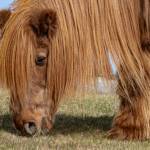Alternative to Pergolide Shows Promise in Horses

Some horses with pituitary pars intermedia dysfunction (PPID, equine Cushing’s disease) either do not respond to pergolide or suffer from anorexia while being treated. Cabergoline, a long-acting intramuscular injection, may be a viable alternative.*
PPID occurs due to the overproduction of certain hormones, such as adrenocorticotropic hormone (ACTH), by the pars intermedia, a region of the pituitary gland. Providing dopamine agonists that mimic the action of dopamine can inhibit the overproduction of ACTH, improving the clinical signs of the disease. The most common signs of PPID include abnormal coat growth and shedding, laminitis, excessive drinking and urinating, lethargy, and muscle wasting.
“Pergolide is the go-to medication for horses diagnosed with PPID. Because horses require daily oral administration of this medication, some horses become resistant to treatment, refusing the medication and making owners less compliant with regular dosing,” explained Catherine Whitehouse, M.S., a Kentucky Equine Research advisor.
Like pergolide, cabergoline is also a dopamine agonist but instead of being administered orally, cabergoline is a long-acting product administered intramuscularly once weekly.
To determine if this product was an effective therapy in horses diagnosed with PPID, medical records from 40 client-owned horses being treated with either high- or low-dose cabergoline were reviewed.
Circulating ACTH levels are high in horses with PPID. To measure response to therapy, ACTH levels are measured periodically, and those levels should decrease compared to pretreatment levels, close to the seasonally adjusted reference range. Improvement in clinical signs is also assessed to determine the effectiveness of therapy.
“After a single dose of cabergoline, ACTH levels decreased significantly from 153 pg/mL to 57 pg/mL (5-8 days post administration), with 41% of horses below the seasonal reference range. Long-term data were equally promising, with horses showing a reduction in ACTH levels and 54% below the seasonally adjusted reference range,” Whitehouse said.
These results are similar to those achieved using pergolide.
“Further, 84% of owners reported improvements in their horses’ clinical signs, and owners reported good compliance,” Whitehouse said.
Adverse events were rarely reported and included self-limiting lethargy and mild colic. Partial anorexia was reported in nine horses (30%) on the low-dose and six horses (60%) on the high-dose for 12-36 hours following injection. During partial anorexia, horses preferred forage sources over concentrate feed. No injection site reactions occurred.
At the end of this study, 25 of the 40 horses continued treatment with cabergoline (5 on high dose and 20 on low dose). Only two stopped treatment due to anorexia, two became refractory to the injections, and two due to owner finances.
Based on the results of this preliminary study, the authors concluded, “Once weekly injection of extended-release cabergoline may be an effective treatment for horses with PPID and provides a basis for designing more robust investigations.”
Data comparing high- and low-dose cabergoline showed the low-dose (0.005 mg/kg) may be more appropriate.
“Older horses, particularly those with PPID, often require regular diet evaluations to ensure they are maintaining an ideal body weight, and careful consideration may be needed regarding the amount and type of calories provided,” shared Whitehouse. “In addition to providing a balanced diet in both calories and nutrients to senior horses, supplementing with omega-3 fatty acids and key antioxidants such as vitamin E and C help support their immune systems.”
*Sundra, T., E. Kelty, G. Rossi, and D. Rendle. 2024. Retrospective assessment of the use of extended-release cabergoline in the management of equine pituitary pars intermedia dysfunction. Frontiers in Veterinary Science 11:1332337.








